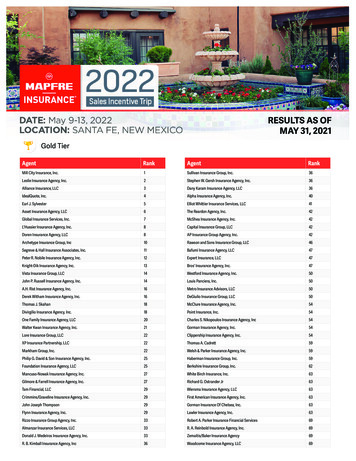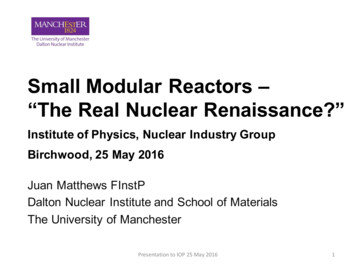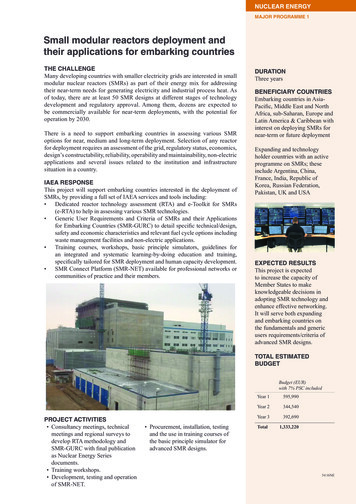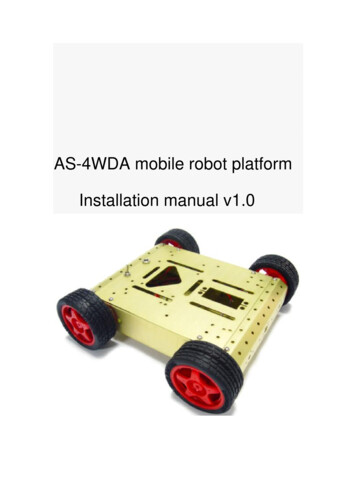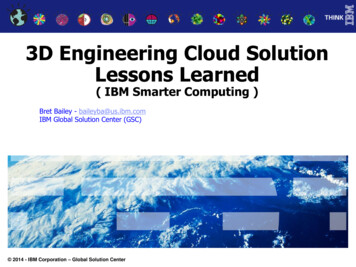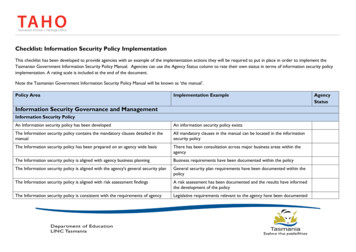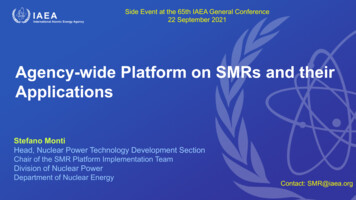
Transcription
Side Event at the 65th IAEA General Conference22 September 2021Agency-wide Platform on SMRs and theirApplicationsStefano MontiHead, Nuclear Power Technology Development SectionChair of the SMR Platform Implementation TeamDivision of Nuclear PowerDepartment of Nuclear EnergyContact: SMR@iaea.org
Agency-wide Platform on SMRs and their ApplicationsObjective: Provide national governments, experts andregulators with integrated Agency-wide support on allaspects of SMR development, deployment and oversightWhat?How?IAEA’s internal governanceto coordinate activitiesconsistently with MSsneeds and requestsSingle access point for MSsand stakeholders Develop medium-term strategyon SMR and its applications Create enabling environmentand a portal to enhance internalas well as externalcommunicationWhy? Member Sates request for consistent,coordinated and optimized Agency supportEffective and efficient support to Member States,International Organizations and stakeholderswilling to cooperate with the IAEA
Agency-wide Platform onSmall Modular Reactors andtheir Applications SMR SteeringCommittee(SMR-SC) Kick-off meeting held on2 July 2021 Second Meeting held on12 August 2021 Third Meeting scheduledfor 28 Sep 2021 Kick-off meeting held on 27 May 2021SMR PlatformImplementation Team(SMR-PIT)Led & coordinated by NE DepartmentDG
Medium Term Strategy (2022-2027)Methodologyi. First an environmental scan should be performed to identify MSs needs and gapsin IAEA programmeii. Based on the environmental scan the IAEA strategic objectives in the mediumterm should be established and definediii. Describe the expected outcomes in member states if strategic objectives will bemet, along with the associated risk analysisDraft StructureI.Introduction - strategic enablersII. Outcomes of the environmental ScanningIII. Strategic ObjectivesIV. Expected Outcomes in Member States
II. Environmental ScanningInformation Collection and Proposed msSMRPITSMRSCTable of Contentsand ExecutiveSummaryDGExpectedsubmission for DGapproval in 2022First draft structurereadyUnder internalReview
High Level SMR BookletSMRs: A new nuclear energy paradigm1. Understanding SMRs2. Success – what will it take?3. Next steps - Future: what’s next for SMRs –from a decade to perspective for the century4. The IAEATable of ContentReadyAn internal Task Force has beenestablishedKick-off meeting: 15 Sep 2021Expected Releasein 2022InternalDraftingInitiated
SCORPION:SMR Coordination and Resource Portal forInformation Exchange, Outreach and NetworkingDevelop and maintain an 'SMR Portal' which will serve asa controlled internal collaboration tool as well as ameans of sharing information and data with internalstakeholders. The portal will also serve as a centralizedsource of information for external stakeholders with amechanism for registration as well as different level ofdata/info access authorization.- The Task (as per point 26(g) of the ToR)
Proposed Design (first major version)IAEA servicesto MemberstatesResources likepublications, toolkits,databases etc. curated list of nonIAEA publicationsGeneral contactpoint forms toaddress request toSMR - SCIAEA news curated list ofexternal newsIAEA Events: upcoming andarchive (list of last 5 year isready to be verified bydepartments) non-IAEAOfficial workinggroups andforumsBrief informationabout nationaland internationalprojects se in 2022InternalReviewOngoing
New TC Interregional ProjectSupporting Member States’ Capacity Building on Small ModularReactors and Microreactors and their Technology and Applications – AContribution of Nuclear Power to the Mitigation of Climate ChangePeriod: 2022 – 2025Field of Activity (#6 Nuclear Power Reactors)ObjectiveTo improve technical knowledge, capacitybuilding and safety review capability indeveloping countries addressing thefundamental aspects of SMRs/MRs andtheir electric and non-electric applications.OutcomeAwareness raised on SMRs/MRstechnology and their applications toenhance nuclear energy contributionin social-economic development inMember StatesCurrently under approval by BoG
Thank you!SMR@iaea.org
Side Event at the 65th IAEA General Conference22 September 2021Member States’ Perspectives on SMRDevelopments for Near Term DeploymentMarco RICOTTIChair of IAEA Technical Working Group forSmall and Medium sized or Modular Reactors (TWG SMR)Politecnico di Milano, ITALY
TWG-SMR established in Q1/2018
The functions of the TWG To provide advice to DDG-NE on specific topics of relevance to theIAEA’s programmatic activities; To share information and knowledge on national and internationalprogrammes; To contribute to the development of selected IAEA publications, assessexisting gaps and advise on the preparation of new publications; Upon request, to present to the Standing Advisory Group on NuclearEnergy (SAGNE) the key findings of the TWG meeting; and To share experience and advice on increasing the participation of youngprofessionals and improving the gender balance in the nuclear sector.DDG-NE appoints Members in their individual capacity followingtheir endorsement by their respective Member State(s).
International Technical Working Group on SMR(2018 – 2021 Cycle) Chairperson: Mr. Marco RICOTTI, Politecnico di Milano, ItalyTo advice and support IAEA programmatic planning and implementation in areas related totechnology development, design, deployment and economics of SMRsNow 21 Member States and two International Organizations: European Commission and OECDNEA as invited observers:Three technical subgroups established: SG-1: Development of Generic Users Requirements and Criteria (GURC) SG-2: Research, Technology Development and Innovation; Codes and Standards SG-3: Industrialization, design engineering, testing, manufacturing, supply chain, andconstruction technology Three General Meetings conducted : 2018, 2019, 2020 (virtual), the last TWG-SMR Meeting wasin September 2021 Information SitePages/Home.aspx
SG-1: Development of Generic Users Requirementsand Criteria (GURC)IAEA GURC for SMR TechnologyDefinition: a comprehensive statement that reflects key policy of a Member State on the expectations of itsuser/owner/operator on SMR technology for their nuclear power plant(s)Rationale: User organizations in developing countries embarking on NPP with SMRs do not necessarily haveaccess to the established utility requirements from advanced countries aforementioned;Nature: Complementary to Reactor Technology Assessment and Technology Roadmap for SMRDeployment;Interdisciplinary subjects, cross-cutting between Reactor Technology with: Engineering, Infrastructure, NuclearEnergy System Sustainability, Economics & Financing, Fuel Cycle & Waste Management, Safety Assessment,Security, Safeguards, Regulatory Oversight & Licensing, Siting, Environment, and so forth.Key Benefit for Member States:- Facilitate embarking countries in conducting reactor technology assessment and eventually developing atender document;- Provide a basis for SMR designers and technology developers to offer a licensed SMR product thataddresses/incorporates specific needs of embarking countries;- Provide a basis for strong investor confidence that risks associated with the initial investment to completeand operate the first SMR can be minimized.
SG-1: Development of Generic Users Requirementsand Criteria (GURC)Meetings Conducted and PlannedOutputs First online survey Top 15 GURC elements for SMRtechnology First online Exercise Module onGURC-SMR Presentation and discussion onresponses result of selectedquestions A comprehensive review ofTechnical Evaluation Module (Shortversion) of GURC-SMR, ready forthe 2nd TM A preliminary review of the NuclearEnergy Series Report outline, aGuidance Document on GURCSMR
Coordinated Research ProjectsSG-2: Research, Technology Development andInnovation; Codes and StandardsPassive Engineered Safety Featuresin iPWRs Develop an approach for Designing passive engineered safety features for water cooled SMRs and Offering good practices for assessing their performance and reliability Verification & validation methodologiesCompletedDevelopment of Approaches,Methodologies and Criteria forDetermining the Technical Basis forEmergency Planning Zone for SmallModular Reactor Deployment Definition of consistent approaches, methodologies, criteria to determine needfor off site EPR, including EPZ/D size, for SMR deployment Includes identification of technology specific factors for different SMRs thatmay influence source term and timing of release possible sequences to beconsidered for emergency classification systemCompletedTechnologies to enhance thecompetitiveness and earlydeployment of SMRs and HTRsNew Provides a forum for R&D with the objective to facilitate MS with theformulation of innovative solutions to make SMRs / HTRs more attractiveviable option to diverse markets The Coordinated Research Project will study technologies related to reactordesign and innovative power conversion of SMRs and HTRs to enhance thecompetitiveness and possibilities for deployment
SG-2: Research, Technology Development andInnovation; Codes and Standards Consider risk-based approach for codes and standards. Alternative methods should beconsideredCountry dependent. IAEA can help facilitate information exchange and promote commonapproaches.High temperature Materials for Advanced Reactors included in CodesRequirements for in-service (and commissioning) testing and surveillance for SMRs maybe differentFunctional requirements safety design criteria may be different between SMRs andlarge nuclear reactors. Identify differences in functional and operational requirements, sothat S&C can be modified or exceptions are identified accordinglyEmbarking countries will benefit substantially from the availability of OPEN SOURCEsoftware to be able to calculate SMR design, operational and safety performance:IAEA could facilitate access to these codes and also a conduct workshop or training tointroduce users to this software
SG-2 Codes & Standards – Applicability to SMRsKey Advantage #1: Enabling Design Simplification Minimized number of systems and components without compromising safety;Simplification to improve economics, maintainability and availability of components – withoutcompromising safety.Key Advantage #2: Confirm a robust supply chain: Assure ‘diverse’ supply for replacement by manufacturers other than the original manufacturers;Improve the assurance of sustainable operation of the nuclear power plant.Findings on Standardization: Standardization alone will not solve all issues in advanced reactor product development;Excellence in applying advanced manufacturing and NDE techniques are often proprietary; notreadily shareable or standardized because it would benefit competitorsThe biggest challenge to quality product is to having the capability of designing, manufacturingand delivering, within time and budget, products that meet the requirementsSMR Development should increasingly apply codification and standardization ofAdvanced Manufacturing Techniques to realize high degree of Modularity
SG-3: Industrialization, design engineering, testing,manufacturing, supply chain, and construction technology Support to Achieving Excellence in NPP Operation Power uprate and plant upgrade Construction/Commissioning/Operation Design Change Instrumentation and Control Configuration management Outage and maintenance management Asset Management Ageing/Plant Life Management Corrective action programme Supply Chain Human resource management Training and qualification Leadership Stakeholder involvement Organizational culture and managementof safety and performance
SG-3: Industrialization, design engineering, testing,manufacturing, supply chain, and construction technologyConsultancy on QA and Advanced Manufacturing Challenges faced by the industry, manufacturers and operating nuclear powerplants to implement advanced manufacturing processes while meeting industryquality assurance standards for nuclear power plants. Advanced manufacturingprocesses that can be discussed, but not limited to, are the following:– Structure manufacturing: powder metallurgy, metal additive manufacturing, sparkplasma sintering, cryogenic machining, in-process control and qualification– Welding technology: electron beam welding, sold state friction stir welding, laser welding,in-situ welding control and real-time monitoring, irradiated material welding.– Advanced cladding: cold spray, diode laser cladding, friction stir additive manufacturing– Reactor construction: self-consolidating concrete, high strength rebar, modularconstruction
Agency-wide Supports to TWG-SMRDepartment of Nuclear EnergyDepartment of Nuclear Safetyand Security Economic Appraisal of SMRProject Operation, Maintenance andEngineering HR Development Strategy forDeployment Milestone Approach: itsApplication to Deployment ofSMR Fuel Cycles / Spent Fuel Non-Electric Applications Technology Assessment Design for Decommissioning Legal and Institutional Issuesof Factory-fuelled, Tested andTransportable NPP Licensing andRegulatory Frameworks Applicability of IAEASafety Standards toNovel AdvancedReactors Seismic Design Aspectsand External SafetyEvents considerations inSMR Deployment Instrumentation andControl and ComputerSecurity forMicroreactorsDepartment of Safeguards Safeguards by Design for SMR Proliferation Resistancecharacteristics of SMRDepartment ofTechnical Cooperation TC Interregional Project onsupporting Member States’Capacity Building on SMRs andtheir Applications –A Contribution of Nuclear Powerto Climate Change Mitigation
Member States’ updatesMember StatesKey National Activities, Issues and/or Achievements on SMR since 2019ArgentinaCNEA participates in “High-Performance Advanced Methods and ExperimentalInvestigations for the Safety Evaluation of Generic Small Modular ReactorsAustraliaNational team participates in IAEA CRP on Economic Appraisals of SMR ProjectCanada12 SMR designs in CNSC Vendor Design Review; First SMR a micro in Chalk RiverChinaCriticality of HTR-PM #1; ACP100 started construction, DHR-400 to start constructionFinlandTechno-Economy Evaluation of SMRs for District Heating; Studies on EPZ sizingFranceNUWARD project launched, conceptual design defined, pre-licensing with IRSN – ASNIndialongest continuous operation of KAIGA NPP-1; advanced R&Ds on Molten Salt ReactorsIndonesiaNational priority to complete Feasibility Study on SMR for West Kalimantan (2020-2024)IranCompleted national’s users technical requirements document for selecting SMRsJapanHTTR-30 test reactor received license to re-operate; GTHTR300 design development
Member States’ updatesMember StatesKey National Activities, Issues and/or Achievements on SMR since 2019JordanEvaluation of SMRs since 2017; concerns with techno-maturity & cost competitivenessKenyaCapacity Building through Reactor Technology Assessment for SMR designsRepublic of KoreaCompliance evaluation of SMART Std Design Approval review started by NSSCPakistanViability of SMRs for district-heating for country’s northern region in severe winterRussian FederationAkademik Lomonosov FNPP in operation; RITM-200N to start construction, SHELF-M for remoteSaudi ArabiaJoint R&D projects with KAERI on energy planning and SMR for DesalinationSouth AfricaNuclear Knowledge Management on HTGR-type SMRs, including PBMR-400UkraineEnergoatom active in international for a on SMRs (INPRO, EUR, IFNEC, WNA)United KingdomRolls Royce’s UK-SMR will undertake ONR’s Generic Design Assessment in 2021United States of AmericaNuScale received NRC’s SDA in 9/2020, first module to operate by 2020 in Idaho
MS Recommendations to IAEA Agency-wide Platform on SMR and Applications address coordination issuesIAEA’s support to Member States in supply chain is neededPriority assessment of requirements and clearly defined aspects to be provenApplying state-of-the-art approaches to help promote the deployment of SMRsEmbarking countries expect more information on financial scheme and economicsfrom vendorsInvolvement of all stakeholders and interaction among them at an early stage isneededExpect opportunities to learn from designers’ experience at more advanced stageNational participation and localization are important for newcomer countriesConsidering market, including utility/end-user requirements and the applicationsSynchronizing cooperation with other organizations in related subjectsBusiness models based on standardization and streamlined production help promotethe deployment
Summary of TWG-SMR’s Chairperson The Agency-wide Platform on SMRs and their applications – implements «holistic»approach for consistent and coordinated support to Member StatesFocusing on what is differential for SMRs when compared with current reactortechnologiesEmbarking Countries: increase of awareness and knowledge on SMRs andsupporting their capacity buildingTopics for medium-long term activities on SMRs: Supply chain development; development of industrial codes and standards, and suitabledeployment strategiesSMR Regulators and stakeholders interactionInvolvement of experts from non-nuclear communities (e.g., H2, cogen., grid TSOTransmission System Operators); potential key role of SMRs as «green solution»HR development (non-standard SMR solutions, supply chain development/ qualification/organisation, economics/ business models, cogen. systems & processes)Understanding the requirements and criteria of the users of SMRs
Thank you!
Update on the SmallModular ReactorRegulators’ ForumSide Event GC65 – Discussion on Agency WideIAEA Platform on SMRs and their Applications,Wednesday, 22 September 2021,12:30 – 14:00 CESTMarcel de Vos, Senior Project OfficerNew Major Facilities Licensing DivisionCanadian Nuclear Safety Commission1
What is the SMR Regulators’ Forum?Self-funded Regulator-to-Regulator group forcollaboration on SMR Issues (water-cooled and advanced concepts)Members CanadaChinaFinlandFranceKorea Russian FederationSaudi ArabiaSouth AfricaUnited KingdomUnited StatesObservers: Joint Research Centre (EC) OECD Nuclear Energy Agency WNA-CORDELIAEA - Scientific Secretariat on Forum Steering CommitteeObjectives and work driven by its members2
Objectives of the Forum Share regulatory experience amongst Forum members preparing to: Facilitate efficient, robust, and thorough regulatory decisions Encourage enhanced nuclear safety and security Facilitate international cooperation among regulators performing SMR-related assessments Identify and discuss common safety issues that may challenge regulatoryreviews associated with SMRs and, if possible, recommend commonapproaches for resolution Advise IAEA on the need for revision or development of new IAEApublications on safety of SMRsEmphasis is placed on supporting near-term regulatory needsbut long term objectives are part of discussions3
Examples of near-term versus long termregulatory areas of interest Near-term – First of a KindLeveraging information betweenregulators based on experienceImplications of modular design andmodular constructionKey areas of regulatory interest inlicensing process/conduct of regulatedactivitiesFactors in risk informed assessment ofsafety claims and evidence (use ofGraded Approach) Long-term – “Nth” of a KindMutual recognition of regulators’assessment/ Joint assessments/CollaborationSerial manufacturing/constructionTransportable factory fueledreactorsImproving sharing of experienceon regulatory oversightEnhancing and aligningrequirements and guidance usingcase studies and experience4
Outcomes of the Forum Common position statements on regulatory (policy and technical) issues IAEA safety framework is the benchmark but member frameworks and experience informdevelopment of common positions Suggestions for revisions of, or drafting of, IAEA documents, especially onpotential enhancements to the IAEA Safety Standards and Guides with respectto SMRs Generation and sharing of information that regulators may use to enhance theirregulatory framework Descriptions of regulatory challenges and discussions on paths forward Suggestions for high level issues to be raised to international organizations fordispositioning (e.g. WANO, Standards Developers etc)Stress the importance of a Member State’s effective & independent regulatory function5
Completed work of the Forum (2015-2020)Phase 1 (2015 - 2017) Graded Approach Defence-in-Depth Emergency Planning Zone SizePhase 2 (2018 - 2020) Licensing Issues Design and Safety Analysis Manufacturing, Commissioning and OperationCompleted reports for Phases 1 and 2 are posted on the Forum’s web-page ors/smr-regulators-forum6
Graded Approach Working Group (Phase 1) Clarified what the term Graded Approach means Exists in the IAEA safety framework as well as frameworks of all regulators Tools and processes for risk-informed decision making are integral to a Graded Approach Confidence in supporting evidence for proposed safety provisions plays an important role Recommended: “ IAEA to lead thedevelopment of a technical document that further explains what the Graded Approach isand how it is used to ensure safety”Lessons learned inform the work of current Forum activities.The IAEA leveraged this work in developing a new 2021 TECDOC:Application of a Graded Approach in Regulating Nuclear Installations7
Defence in Depth Working Group (Phase 1) Defence in Depth (DiD) is a technology-neutral fundamental principle for ensuring nuclearsafety and is a fundamental basis for the design and safety demonstration of SMRs Use of fault-tolerant fuels, innovative coolants, and inherent and passive characteristicsinfluence how provisions are put in place for the different levels of DiD Seeing increased emphasis on robust design for Levels 1-3 to seek need for less provisions at Levels 4and 5 Some design features cover more than one level. Raises question: How are levels of DiD independent tothe extent practicable? All five levels of DiD need to be addressed in a safety demonstration Safety and control provisions for each level need to be commensurate with confidence in theperformance of provisions for previous levels Need confidence in characterization and analysis of events and progression Multiple unit facilities need to consider common cause events or failures of shared features.Work continued in Design and Safety Analysis Working Group 2018-20208
Emergency Planning Zone (EPZ) Working Group(Phase 1) Reviewed existing practices of member regulators Documented key factors and considerations underpinning the determination of EPZboundaries EPZs can be scaled for facilities depending on: the results of a site-specific hazard assessment, implementation of ‘practical elimination of large releases’ in design activities; and, confidence in the effectiveness of safety and control provisions for the facility Siting of SMRs/advanced reactors in remote regions, near industrial facilities or in higherpopulation regions require special consideration in EPZ determination New types of challenging events? Available infrastructure for emergency response? Response times?New sensitive environments?IAEA rolled these results into the Coordinated Research Project on EPZ for SMRs9
Licensing Issues Working Group (Phase 2 & 3)Phase 2 – Published work in 3 major areas – provided Common Positions andrecommendations to IAEA for areas that should receive follow-up attention: Key Regulatory Interventions (KRI) – areas of strategic regulatory interest in the licensing process(assessment and compliance) emerging in new deployment models for reactor facilities First of a Kind versus Nth-of-a-Kind - How the safety case and licensing for a facility can differ – includesdiscussion on consideration of new entrants into licensing and use of serial manufacturing Licensing of Multiple Unit Facilities – Includes discussions on combined construction/commissioning/operation, sharing of structures, systems and staffIn Progress Now (Phase 3) Framework for mutual recognition of regulators’ assessment/joint assessments/ collaboration –Practical and legal considerations in executing collaborative work Implications of SMR supply chain on licensee’s core safety capabilities to oversee the conduct oflicensed activities10
Design and Safety Analysis Issues Working Group(Phase 2 & 3)Phase 2 – Published work in 3 major areas – provided Common Positions and recommendations toIAEA for areas that should receive follow-up attention: Multi-unit, multi-module aspects of SMRs – Design and safety analysis considerations Considerations in the use of passive and inherent safety features in SMR designs - Expectations andregulatory assessment of passive and inherent safety features Aspects of beyond design basis analysis relevant to SMRs – Consideration of safety features at Level 4defence-in-depth including design extension conditions, severe accidents and the concept of ‘practicalelimination’ as introduced in Specific Safety Requirements SSR 2/1In Progress Now (Phase 3) Integration of Security, Safeguards and Safety-by-Design principles – Focus on SMR characteristics andfeatures (e.g. underground siting, sealed cores, autonomous and remote operation technologies, transportof factory fuelled modules etc.) Clarifying requirements for confinement and design provisions for containment – Exploring safetyfunctions and how they interface with safety features in consideration of appropriate barriers to releases11
Manufacturing, Construction, Commissioning,Operations Working Group (Phase 2 & 3)Phase 2 – Published work in 4 major areas – provided Common Positions and recommendations to IAEA forareas that should receive follow-up attention: Manufacturability, supply chain management and commissioning of SMRs – discusses the concept of modularityand presents common regulatory positions on manufacturing, construction, and First of a Kind commissioning Collection and Use of Experience in the Lifecycle of Small Modular Reactor facilities – In many cases OperatingExperience with SMRs is limited and therefore needs to be adapted or collected and sufficiently justified to supportactivities related to the entire lifecycle Conduct of Maintenance in an SMR –Discussions need to address the conduct of maintenance as early as possiblein design taking into account Human Performance Conduct of Co-activities and Combined Activities on a Multiple Unit Small Modular Reactor Facility Site discusses safety considerations that need to be considered up front in the designIn Progress Now (Phase 3) Regulatory Considerations in Long Lead Items– Implications of SMRs and advanced reactors to long lead item(services and goods) engagement with regulators prior to the licensing process for a specific facilityCapabilities of the supply chain when supporting licensees – implications of new ownership models, new andmore internationally dispersed suppliers joining the industryImplications of SMR deployment on Configuration Management – managing configurations across a fleet offacilities, including implementing engineering changes as designs are optimized over time12
Supporting ongoing IAEA work on SMRs andAdvanced Reactors Forum members with expertise in specific areas also contribute to IAEAtechnical meetings and consultancies outputs of the Forum are promoted for use in drafting of IAEA documents Significant contribution to Consultancy on Applicability of IAEA Standards andGuides to Advanced Reactors Consultancy attendees from regulators, industry and academia performed a detailedreview of specific standards and guides to identify potential gaps or areas that requireadditional clarification Many recommendations made point to specific analysis outputs of the Forum to beconsidered13
Supporting harmonization ofregulatory practices The Forum showcases agreement between regulators on specific nuclear safetyissues Outputs of the Forum can be promoted and leveraged to clarify/improve IAEA safetystandards and guides In many cases, outputs show that information already contained in the IAEA Safety Frameworkcan be used – with intelligent interpretation Many recommendations are for supplemental guidance in specific technical areas Recommendation made to consider the Forum’s reports in the work of the IAEA Consultancieson Applicability of Safety Standards to Advanced reactors Outputs being used in other bilateral cooperation arrangements between regulators(e.g. joint engagements with technology developers)In consideration of the needs of Member States embarking in Nuclear Power programmes14
Promotion of the Forum’s Work to Other MemberStates Organized as Regional Workshops (WS) Target audience: Member States Regulatory Body staff Divided into 2 components: IAEA presents progress made on all fronts of SMRs (technology, safety, legal) Forum members to present the Forum’s outputs 1 WS planned in Jordan for December 2021 – For region: West Asia/Africa) 4 WS planned in 2022 AMSSNUR-Morocco March 2022 ARN-Argentina, June 2022 East Asia, Central-East Europe Funded through Forum members’ contributions15
Agency-wide Platform: General comments Greater coordination between departments across the agency will be useful How it is structured and communicated out to the public will be very important Structure and work under the platform must clearly show that regulatoryindependence is maintained Demonstration of safety, security, safeguards performance of SMRs and advancedreactor technologies must remain a clear priority Mechanisms to enable improved and timely access
- Provide a basis for SMR designers and technology developers to offer a licensed SMR product that addresses/incorporates specific needs of embarking countries; - Provide a basis for strong investor confidence that risks associated with the initial investment to complete and operate the first SMR can be minimized.
